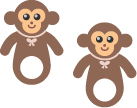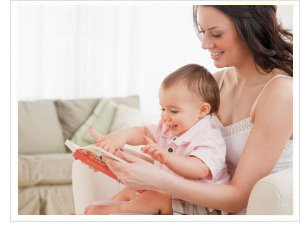A method for teaching to read:
The Flash Method


Method
The Doman program with reading flash cards can begin any time from the age of 3 months. The following is a summary of the method presented in How To Teach Your Baby To Read:
Word selection
- Start with words that are familiar or interesting to your child – words in his environment, words that you use often, e.g. people’s names, objects around the house, common everyday vocabulary. Your child will benefit greatly from lessons using reading flash cards tailored specifically to him.
- Choose words that you know your child will enjoy or find interesting. Short words that look alike – e.g. “cat,” “hat,” “sat” – are boring. Words like “spaghetti” or “refrigerator” are interesting. Children taught parts of the body invariably find the word “belly button” the most fun, and therefore memorable.
- Do include long and unusual words. It’s easy to confuse words that look alike; much harder to confuse a word like “spaghetti” with another word.
Material preparation
- Initially, make the words big and red. A card should be about the length of one and a half pieces of A4 paper, with the word filling most of the card. Explains GD, “In order to understand language through your ear, it has to be loud, clear and repeated… In order to read a language, it must be large, clear and repeated.”
- To fit increasing numbers of words to a card, you will be reducing the text size. Do so gradually, and monitor your child’s reaction at every stage. Go back to a larger text size if your child appears uncomfortable.
- Once you child is comfortable with the reading process, switch to black text. Black is easier on the eye than red when there are more words to a card.
- Write the word on the back of the card for your own reference (you can write it small) – you will say the word at the moment you flash the card to your child.
- Prepare 200 words initially and always have 200 words ready to go. Notes JD in a parent seminar, “It is important to be ahead of your child, because your child will not move at the same rate. He will begin at what seems like a very fast rate to you, and then he’ll speed up.”
- Organize the words into categories (e.g. “home,” “animals,” “colors”).
Lesson presentation
- Flash the cards rapidly, showing each one to your child for less than one second . Explains JD, “There is a natural rhythm to the way we human beings learn, and the rhythm for tiny children is much faster than it is for adults.”
- Glance at the word on the back of the card, and say the word while maintaining eye contact with your child.
- Be sure to retain a lively tone to your voice.
- Be sensitive to your child’s mood and reactions to the lesson as it progresses.
- Show the cards in sets of five, three times per day. Children learn through consistency and repetition.
Shuffle the cards before every lesson. “Little kids are brilliant at sequence,” says JD. Show a set of five cards in the same order twice and your child will probably have the sequence memorized!
After five days, replace one card in every category. A repetition of 15 times is plenty, and you do not want to risk boring your child. You also don’t need to obsess about your child remembering every single word. Says JD, “It would be much better if he ended up knowing 50 percent of 2,000 words than 100 percent of 20 words.”
Progression
- Single words – These are how you introduce new vocabulary. Even for an older child who already knows how to read, it can be useful to go back to single words in order to introduce a more sophisticated subject.
- Couplets – Take two retired words and put them together (e.g. “orange juice”). Once you have amassed a few hundred single words, try out a couplet at the end of a category of single words.
- Phrases (three words) – Use your retired words to write, for example, “Mommy hugs Daddy.” Have five to a category. Alternatively, take out the single cards that you would normally use. With an older child (three to four years of age), you can set a timer for 1-2 minutes and see how many phrases you can make up together.
- Sentences (four or more words) – See “Phrases.”
- Books – Make your own from the get-go. You can even make books from single words – a word on one page, picture on another page. Later, you can make couplet books or books of simple phrases. Once again, you can make books that are exactly suited to your child. Be sure to keep the pictures and words separate, so they don’t distract one from the other.
Rule of thumb
If your child looks unhappy when you pick up the cards, postpone the lesson. If your child looks unhappy during a lesson, stop the lesson. If a particular word makes your child look unhappy, put away the card -destroy it even. Says JD, “On a good day, you do a lot of it; on a bad day, you don’t do it at all. You don’t touch it with a 50ft pole on a bad day.”
In conclusion, she says:
Joyousness! If you only remember one thing, it would be this word. This word all by itself will get you to where you want to go.
Got a question about teaching babies with flash cards? Check out the Flash Card FAQs page. To learn about alternative teaching methods, go to the Free Downloads section.